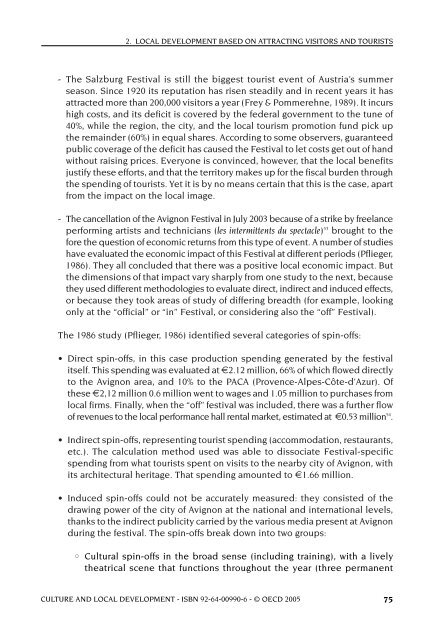OECD Culture and Local Development.pdf - PACA
OECD Culture and Local Development.pdf - PACA
OECD Culture and Local Development.pdf - PACA
Create successful ePaper yourself
Turn your PDF publications into a flip-book with our unique Google optimized e-Paper software.
2. LOCAL DEVELOPMENT BASED ON ATTRACTING VISITORS AND TOURISTS<br />
- The Salzburg Festival is still the biggest tourist event of Austria’s summer<br />
season. Since 1920 its reputation has risen steadily <strong>and</strong> in recent years it has<br />
attracted more than 200,000 visitors a year (Frey & Pommerehne, 1989). It incurs<br />
high costs, <strong>and</strong> its deficit is covered by the federal government to the tune of<br />
40%, while the region, the city, <strong>and</strong> the local tourism promotion fund pick up<br />
the remainder (60%) in equal shares. According to some observers, guaranteed<br />
public coverage of the deficit has caused the Festival to let costs get out of h<strong>and</strong><br />
without raising prices. Everyone is convinced, however, that the local benefits<br />
justify these efforts, <strong>and</strong> that the territory makes up for the fiscal burden through<br />
the spending of tourists. Yet it is by no means certain that this is the case, apart<br />
from the impact on the local image.<br />
- The cancellation of the Avignon Festival in July 2003 because of a strike by freelance<br />
performing artists <strong>and</strong> technicians (les intermittents du spectacle) 53 brought to the<br />
fore the question of economic returns from this type of event. A number of studies<br />
have evaluated the economic impact of this Festival at different periods (Pflieger,<br />
1986). They all concluded that there was a positive local economic impact. But<br />
the dimensions of that impact vary sharply from one study to the next, because<br />
they used different methodologies to evaluate direct, indirect <strong>and</strong> induced effects,<br />
or because they took areas of study of differing breadth (for example, looking<br />
only at the “official” or “in” Festival, or considering also the “off” Festival).<br />
The 1986 study (Pflieger, 1986) identified several categories of spin-offs:<br />
• Direct spin-offs, in this case production spending generated by the festival<br />
itself. This spending was evaluated at €2.12 million, 66% of which flowed directly<br />
to the Avignon area, <strong>and</strong> 10% to the <strong>PACA</strong> (Provence-Alpes-Côte-d’Azur). Of<br />
these €2,12 million 0.6 million went to wages <strong>and</strong> 1.05 million to purchases from<br />
local firms. Finally, when the “off” festival was included, there was a further flow<br />
of revenues to the local performance hall rental market, estimated at €0.53 million 54 .<br />
• Indirect spin-offs, representing tourist spending (accommodation, restaurants,<br />
etc.). The calculation method used was able to dissociate Festival-specific<br />
spending from what tourists spent on visits to the nearby city of Avignon, with<br />
its architectural heritage. That spending amounted to €1.66 million.<br />
• Induced spin-offs could not be accurately measured: they consisted of the<br />
drawing power of the city of Avignon at the national <strong>and</strong> international levels,<br />
thanks to the indirect publicity carried by the various media present at Avignon<br />
during the festival. The spin-offs break down into two groups:<br />
• Cultural spin-offs in the broad sense (including training), with a lively<br />
theatrical scene that functions throughout the year (three permanent<br />
CULTURE AND LOCAL DEVELOPMENT - ISBN 92-64-00990-6 - © <strong>OECD</strong> 2005 75














